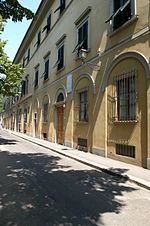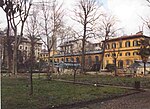Palazzo Capponi, Florence
1717 establishments in ItalyBaroque architecture in FlorenceBuildings and structures completed in 1717Houses completed in the 18th centuryItalian building and structure stubs ... and 1 more
Palaces in Florence
The Palazzo Capponi is a Baroque palace located on Via Gino Capponi #26 in Florence, region of Tuscany, Italy. There are apparently three other palaces once associated with the Capponi family: Palazzo Capponi-Covoni. Palazzo Capponi-Vettori. Palazzo Capponi alle Rovinate.
Excerpt from the Wikipedia article Palazzo Capponi, Florence (License: CC BY-SA 3.0, Authors).Palazzo Capponi, Florence
Via Gino Capponi, Florence Quartiere 1
Geographical coordinates (GPS) Address Website Nearby Places Show on map
Geographical coordinates (GPS)
| Latitude | Longitude |
|---|---|
| N 43.7782 ° | E 11.2634 ° |
Address
Giardino di Palazzo Capponii
Via Gino Capponi
50112 Florence, Quartiere 1
Tuscany, Italy
Open on Google Maps











